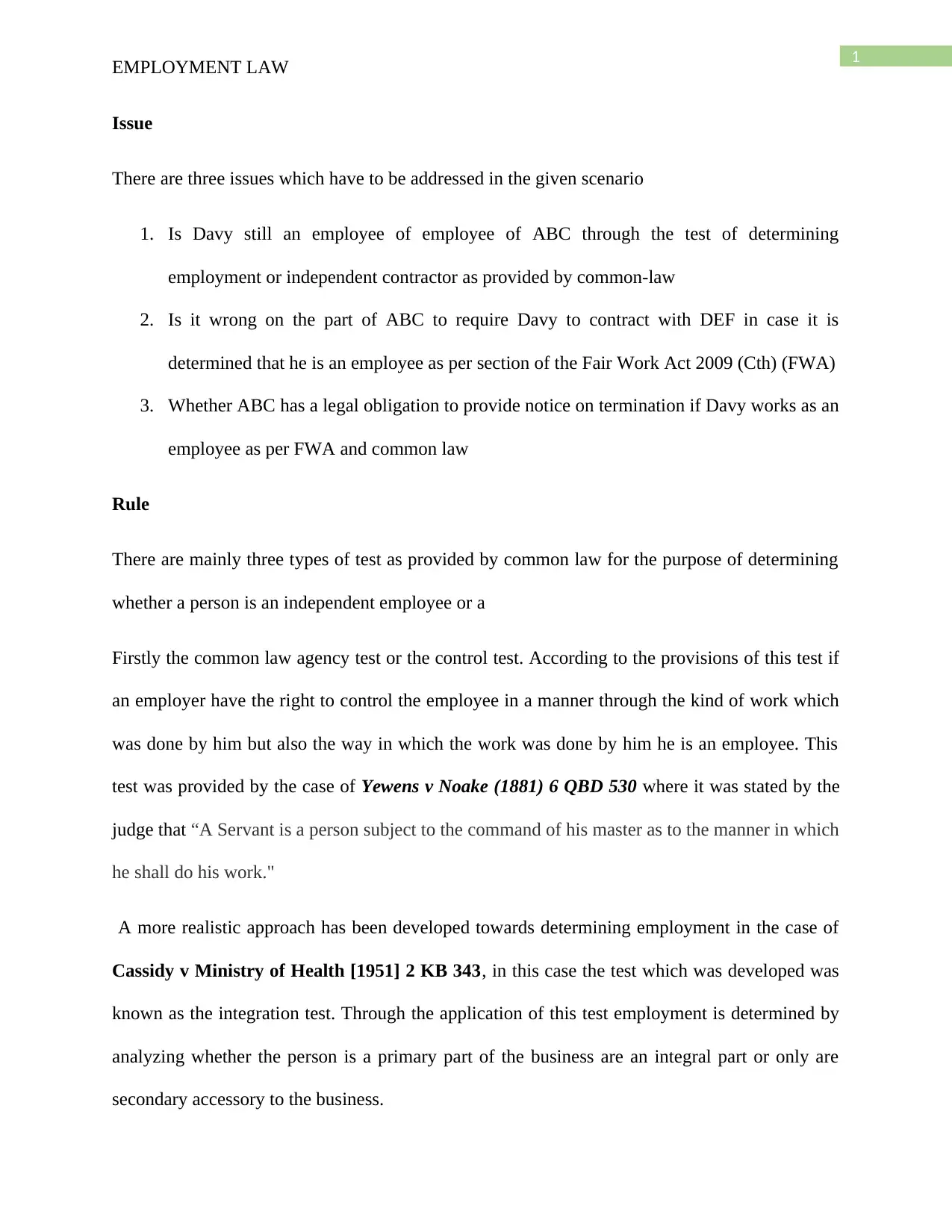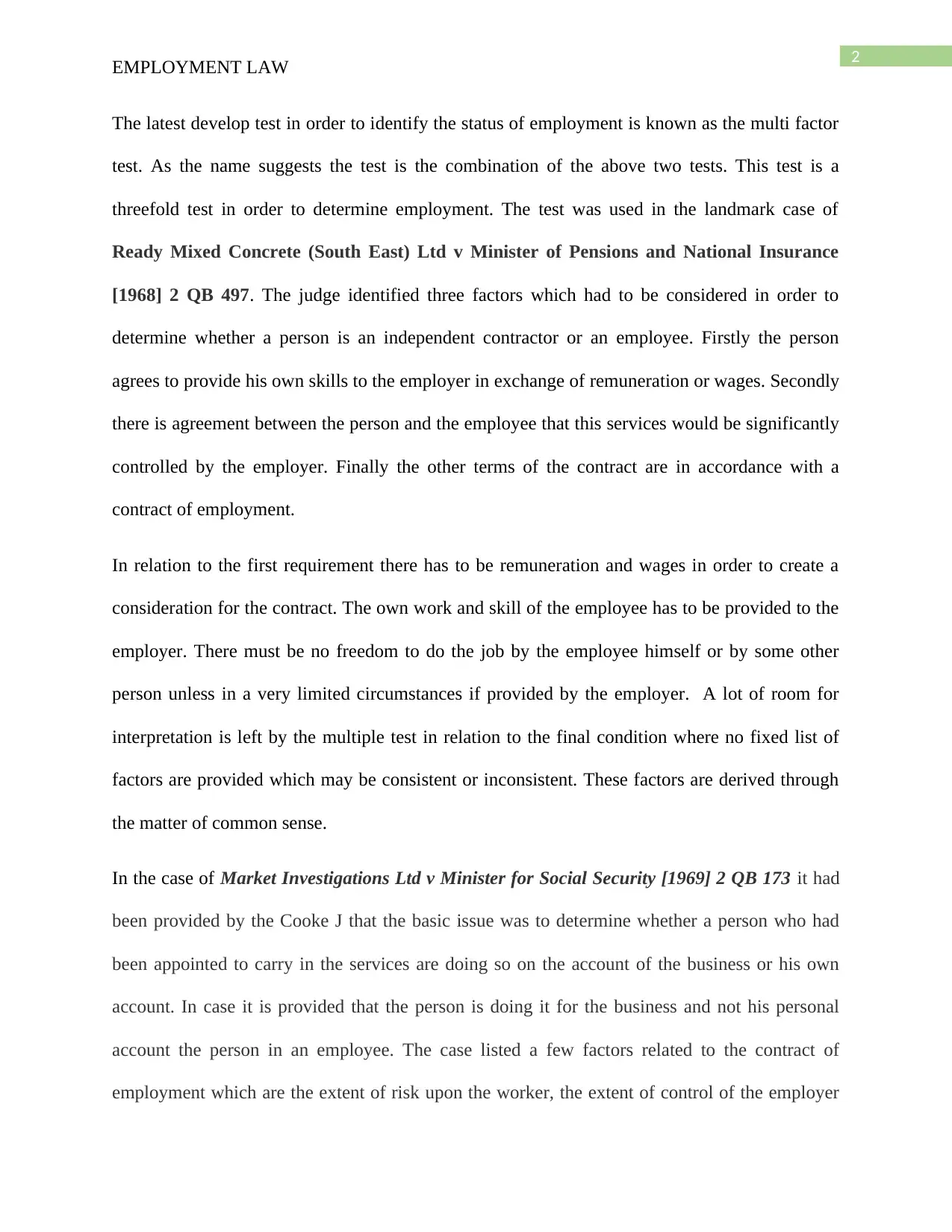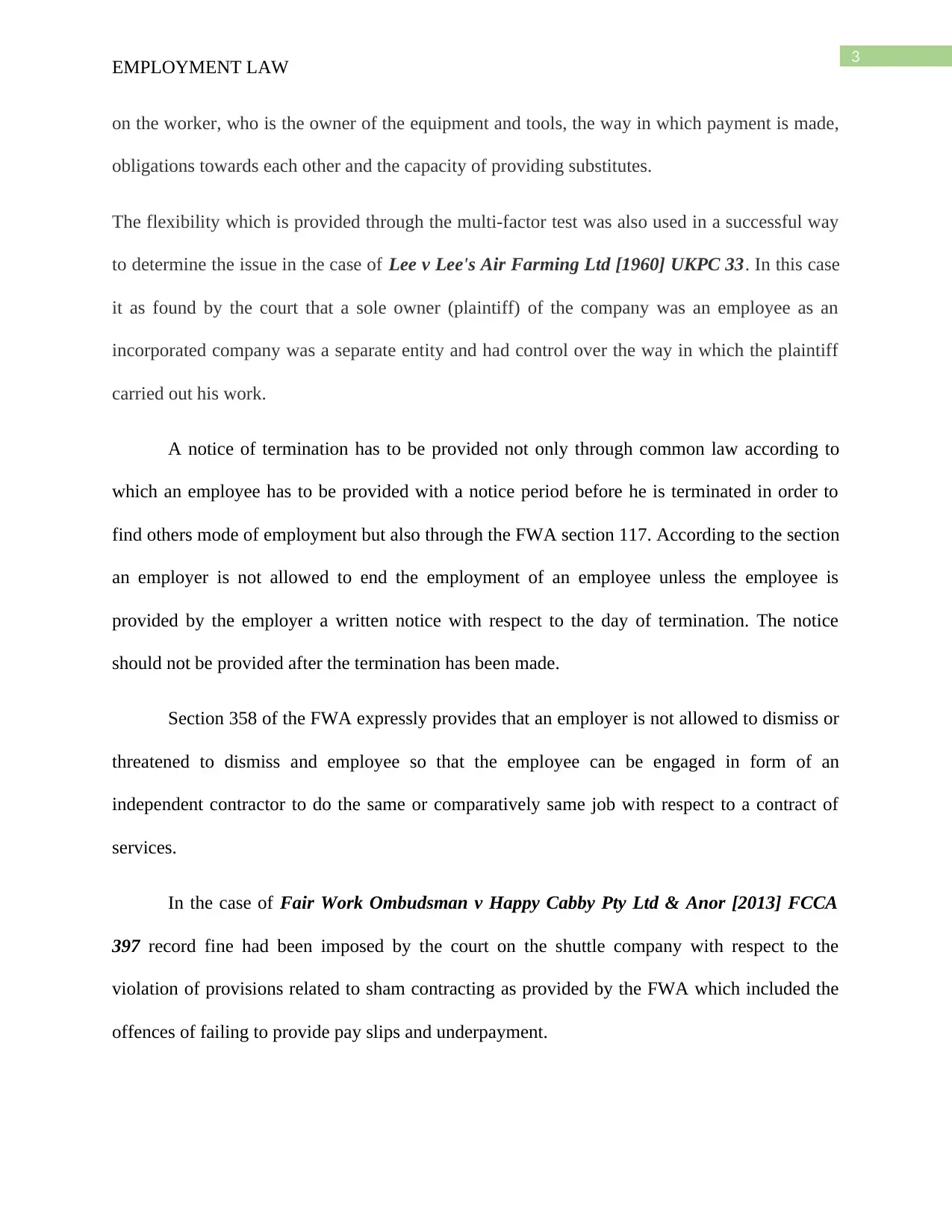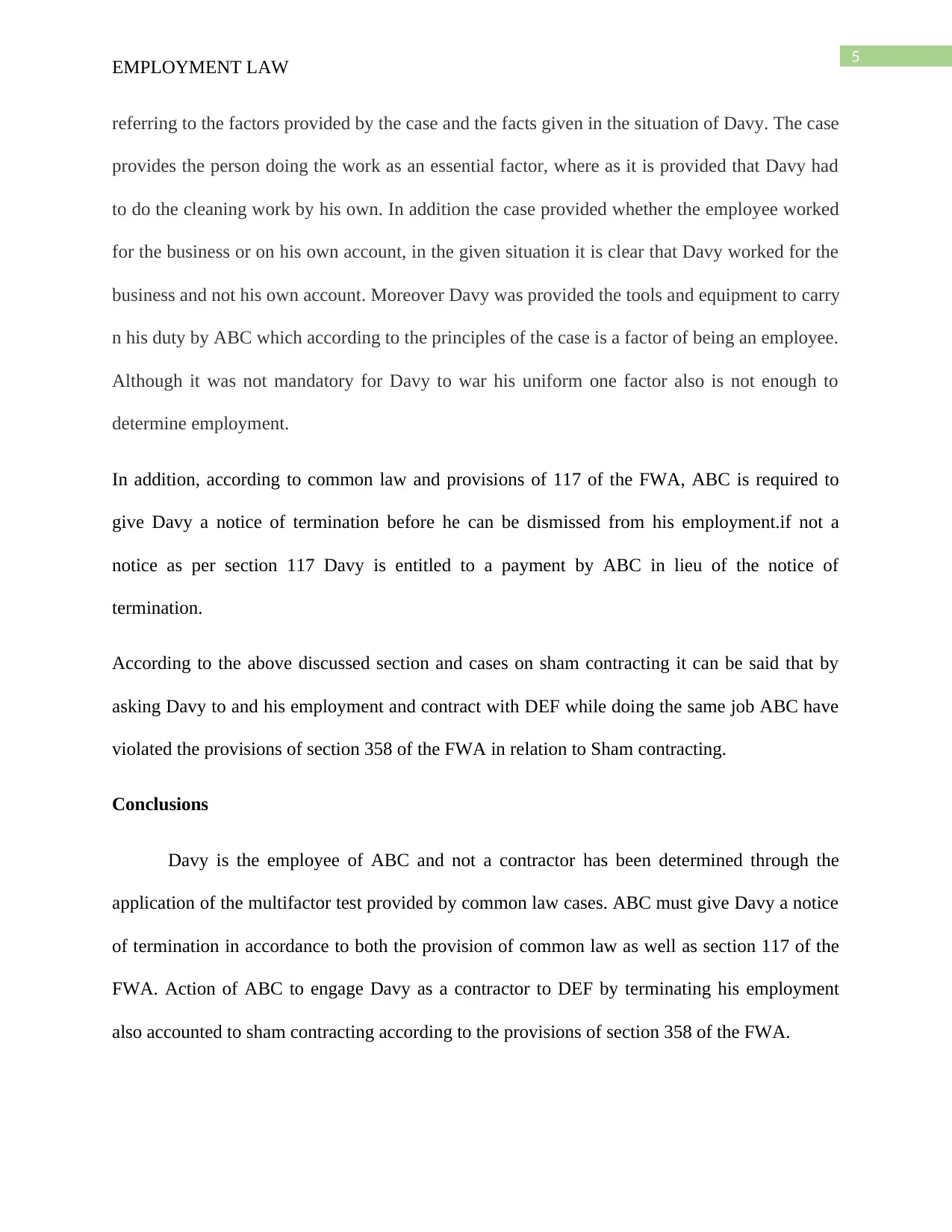Employment Law: Analyzing Davy's Employment with ABC and DEF
VerifiedAdded on 2020/03/16
|7
|1822
|38
Report
AI Summary
This report examines the employment status of Davy in relation to ABC, focusing on whether Davy is an employee or an independent contractor. The analysis applies common-law tests, including the control test, integration test, and the multi-factor test, referencing key cases like *Ready Mixed Concrete (South East) Ltd v Minister of Pensions and National Insurance* and *Market Investigations Ltd v Minister for Social Security*. The report determines that Davy is an employee based on the application of these tests. Furthermore, the report addresses the legal obligations of ABC regarding termination notice, as per both common law and the Fair Work Act 2009 (Cth), specifically section 117. It concludes that ABC's actions potentially constitute sham contracting, violating section 358 of the FWA. The report provides a comprehensive legal analysis of the scenario, citing relevant legislation and case law to support its conclusions.

Running head: EMPLOYMENT LAW
Employment Law
Name of the student
Name of the university
Author note
Employment Law
Name of the student
Name of the university
Author note
Paraphrase This Document
Need a fresh take? Get an instant paraphrase of this document with our AI Paraphraser

1
EMPLOYMENT LAW
Issue
There are three issues which have to be addressed in the given scenario
1. Is Davy still an employee of employee of ABC through the test of determining
employment or independent contractor as provided by common-law
2. Is it wrong on the part of ABC to require Davy to contract with DEF in case it is
determined that he is an employee as per section of the Fair Work Act 2009 (Cth) (FWA)
3. Whether ABC has a legal obligation to provide notice on termination if Davy works as an
employee as per FWA and common law
Rule
There are mainly three types of test as provided by common law for the purpose of determining
whether a person is an independent employee or a
Firstly the common law agency test or the control test. According to the provisions of this test if
an employer have the right to control the employee in a manner through the kind of work which
was done by him but also the way in which the work was done by him he is an employee. This
test was provided by the case of Yewens v Noake (1881) 6 QBD 530 where it was stated by the
judge that “A Servant is a person subject to the command of his master as to the manner in which
he shall do his work."
A more realistic approach has been developed towards determining employment in the case of
Cassidy v Ministry of Health [1951] 2 KB 343, in this case the test which was developed was
known as the integration test. Through the application of this test employment is determined by
analyzing whether the person is a primary part of the business are an integral part or only are
secondary accessory to the business.
EMPLOYMENT LAW
Issue
There are three issues which have to be addressed in the given scenario
1. Is Davy still an employee of employee of ABC through the test of determining
employment or independent contractor as provided by common-law
2. Is it wrong on the part of ABC to require Davy to contract with DEF in case it is
determined that he is an employee as per section of the Fair Work Act 2009 (Cth) (FWA)
3. Whether ABC has a legal obligation to provide notice on termination if Davy works as an
employee as per FWA and common law
Rule
There are mainly three types of test as provided by common law for the purpose of determining
whether a person is an independent employee or a
Firstly the common law agency test or the control test. According to the provisions of this test if
an employer have the right to control the employee in a manner through the kind of work which
was done by him but also the way in which the work was done by him he is an employee. This
test was provided by the case of Yewens v Noake (1881) 6 QBD 530 where it was stated by the
judge that “A Servant is a person subject to the command of his master as to the manner in which
he shall do his work."
A more realistic approach has been developed towards determining employment in the case of
Cassidy v Ministry of Health [1951] 2 KB 343, in this case the test which was developed was
known as the integration test. Through the application of this test employment is determined by
analyzing whether the person is a primary part of the business are an integral part or only are
secondary accessory to the business.

2
EMPLOYMENT LAW
The latest develop test in order to identify the status of employment is known as the multi factor
test. As the name suggests the test is the combination of the above two tests. This test is a
threefold test in order to determine employment. The test was used in the landmark case of
Ready Mixed Concrete (South East) Ltd v Minister of Pensions and National Insurance
[1968] 2 QB 497. The judge identified three factors which had to be considered in order to
determine whether a person is an independent contractor or an employee. Firstly the person
agrees to provide his own skills to the employer in exchange of remuneration or wages. Secondly
there is agreement between the person and the employee that this services would be significantly
controlled by the employer. Finally the other terms of the contract are in accordance with a
contract of employment.
In relation to the first requirement there has to be remuneration and wages in order to create a
consideration for the contract. The own work and skill of the employee has to be provided to the
employer. There must be no freedom to do the job by the employee himself or by some other
person unless in a very limited circumstances if provided by the employer. A lot of room for
interpretation is left by the multiple test in relation to the final condition where no fixed list of
factors are provided which may be consistent or inconsistent. These factors are derived through
the matter of common sense.
In the case of Market Investigations Ltd v Minister for Social Security [1969] 2 QB 173 it had
been provided by the Cooke J that the basic issue was to determine whether a person who had
been appointed to carry in the services are doing so on the account of the business or his own
account. In case it is provided that the person is doing it for the business and not his personal
account the person in an employee. The case listed a few factors related to the contract of
employment which are the extent of risk upon the worker, the extent of control of the employer
EMPLOYMENT LAW
The latest develop test in order to identify the status of employment is known as the multi factor
test. As the name suggests the test is the combination of the above two tests. This test is a
threefold test in order to determine employment. The test was used in the landmark case of
Ready Mixed Concrete (South East) Ltd v Minister of Pensions and National Insurance
[1968] 2 QB 497. The judge identified three factors which had to be considered in order to
determine whether a person is an independent contractor or an employee. Firstly the person
agrees to provide his own skills to the employer in exchange of remuneration or wages. Secondly
there is agreement between the person and the employee that this services would be significantly
controlled by the employer. Finally the other terms of the contract are in accordance with a
contract of employment.
In relation to the first requirement there has to be remuneration and wages in order to create a
consideration for the contract. The own work and skill of the employee has to be provided to the
employer. There must be no freedom to do the job by the employee himself or by some other
person unless in a very limited circumstances if provided by the employer. A lot of room for
interpretation is left by the multiple test in relation to the final condition where no fixed list of
factors are provided which may be consistent or inconsistent. These factors are derived through
the matter of common sense.
In the case of Market Investigations Ltd v Minister for Social Security [1969] 2 QB 173 it had
been provided by the Cooke J that the basic issue was to determine whether a person who had
been appointed to carry in the services are doing so on the account of the business or his own
account. In case it is provided that the person is doing it for the business and not his personal
account the person in an employee. The case listed a few factors related to the contract of
employment which are the extent of risk upon the worker, the extent of control of the employer
⊘ This is a preview!⊘
Do you want full access?
Subscribe today to unlock all pages.

Trusted by 1+ million students worldwide

3
EMPLOYMENT LAW
on the worker, who is the owner of the equipment and tools, the way in which payment is made,
obligations towards each other and the capacity of providing substitutes.
The flexibility which is provided through the multi-factor test was also used in a successful way
to determine the issue in the case of Lee v Lee's Air Farming Ltd [1960] UKPC 33. In this case
it as found by the court that a sole owner (plaintiff) of the company was an employee as an
incorporated company was a separate entity and had control over the way in which the plaintiff
carried out his work.
A notice of termination has to be provided not only through common law according to
which an employee has to be provided with a notice period before he is terminated in order to
find others mode of employment but also through the FWA section 117. According to the section
an employer is not allowed to end the employment of an employee unless the employee is
provided by the employer a written notice with respect to the day of termination. The notice
should not be provided after the termination has been made.
Section 358 of the FWA expressly provides that an employer is not allowed to dismiss or
threatened to dismiss and employee so that the employee can be engaged in form of an
independent contractor to do the same or comparatively same job with respect to a contract of
services.
In the case of Fair Work Ombudsman v Happy Cabby Pty Ltd & Anor [2013] FCCA
397 record fine had been imposed by the court on the shuttle company with respect to the
violation of provisions related to sham contracting as provided by the FWA which included the
offences of failing to provide pay slips and underpayment.
EMPLOYMENT LAW
on the worker, who is the owner of the equipment and tools, the way in which payment is made,
obligations towards each other and the capacity of providing substitutes.
The flexibility which is provided through the multi-factor test was also used in a successful way
to determine the issue in the case of Lee v Lee's Air Farming Ltd [1960] UKPC 33. In this case
it as found by the court that a sole owner (plaintiff) of the company was an employee as an
incorporated company was a separate entity and had control over the way in which the plaintiff
carried out his work.
A notice of termination has to be provided not only through common law according to
which an employee has to be provided with a notice period before he is terminated in order to
find others mode of employment but also through the FWA section 117. According to the section
an employer is not allowed to end the employment of an employee unless the employee is
provided by the employer a written notice with respect to the day of termination. The notice
should not be provided after the termination has been made.
Section 358 of the FWA expressly provides that an employer is not allowed to dismiss or
threatened to dismiss and employee so that the employee can be engaged in form of an
independent contractor to do the same or comparatively same job with respect to a contract of
services.
In the case of Fair Work Ombudsman v Happy Cabby Pty Ltd & Anor [2013] FCCA
397 record fine had been imposed by the court on the shuttle company with respect to the
violation of provisions related to sham contracting as provided by the FWA which included the
offences of failing to provide pay slips and underpayment.
Paraphrase This Document
Need a fresh take? Get an instant paraphrase of this document with our AI Paraphraser

4
EMPLOYMENT LAW
In the case of Fair Work Ombudsman v Northern Enterprises Pty Ltd [2013] FCCA
216 it was held by the court that even where the employee was made to enter under a contract of
services, as the employer had control over the employee it accounted to sham contracting.
Application
The control test and the integration test are not very effective alone to determine the
employment status of a person. Therefore in relation to the scenario the multifactor test would be
used to analyzing the position of Davy in relation to ABC.
In the provided situation it has been given that Davy was not clear to be he was
contracted to after he was purported to be terminated from his position as an employee and ask to
work for DEF. Although Davy was not mandatorily required to wear his uniform but he used to
wear his uniform at work. In addition Davy used to use the Van provided by ABC in order to
carry out his work. The work allocation of Davy was still provided by ABC along with the
materials and tools required to complete his work. Therefore, through the application of the multi
factor test as discussed above it can be provided that as Davy worked for ABC in exchange of
remuneration, as work allocations and tools are provided by ABC to Davy it can be said that
ABC had significant control over his work and as he used the van of ABC and mobile phone
these also account to the terms of an employment contract. Therefore it can be provided that
Davy is an employee of ABC not an independent contractor according to the provision of Ready
Mixed Concrete (South East) Ltd v Minister of Pensions and National Insurance case.
In addition through the application of the provisions provided through the case of market
investigations ltd v minister of social security, in relation to the multi-factor test it can further be
strengthened that Davy is an employee of ABC and not a contractor. This can be said by
EMPLOYMENT LAW
In the case of Fair Work Ombudsman v Northern Enterprises Pty Ltd [2013] FCCA
216 it was held by the court that even where the employee was made to enter under a contract of
services, as the employer had control over the employee it accounted to sham contracting.
Application
The control test and the integration test are not very effective alone to determine the
employment status of a person. Therefore in relation to the scenario the multifactor test would be
used to analyzing the position of Davy in relation to ABC.
In the provided situation it has been given that Davy was not clear to be he was
contracted to after he was purported to be terminated from his position as an employee and ask to
work for DEF. Although Davy was not mandatorily required to wear his uniform but he used to
wear his uniform at work. In addition Davy used to use the Van provided by ABC in order to
carry out his work. The work allocation of Davy was still provided by ABC along with the
materials and tools required to complete his work. Therefore, through the application of the multi
factor test as discussed above it can be provided that as Davy worked for ABC in exchange of
remuneration, as work allocations and tools are provided by ABC to Davy it can be said that
ABC had significant control over his work and as he used the van of ABC and mobile phone
these also account to the terms of an employment contract. Therefore it can be provided that
Davy is an employee of ABC not an independent contractor according to the provision of Ready
Mixed Concrete (South East) Ltd v Minister of Pensions and National Insurance case.
In addition through the application of the provisions provided through the case of market
investigations ltd v minister of social security, in relation to the multi-factor test it can further be
strengthened that Davy is an employee of ABC and not a contractor. This can be said by

5
EMPLOYMENT LAW
referring to the factors provided by the case and the facts given in the situation of Davy. The case
provides the person doing the work as an essential factor, where as it is provided that Davy had
to do the cleaning work by his own. In addition the case provided whether the employee worked
for the business or on his own account, in the given situation it is clear that Davy worked for the
business and not his own account. Moreover Davy was provided the tools and equipment to carry
n his duty by ABC which according to the principles of the case is a factor of being an employee.
Although it was not mandatory for Davy to war his uniform one factor also is not enough to
determine employment.
In addition, according to common law and provisions of 117 of the FWA, ABC is required to
give Davy a notice of termination before he can be dismissed from his employment.if not a
notice as per section 117 Davy is entitled to a payment by ABC in lieu of the notice of
termination.
According to the above discussed section and cases on sham contracting it can be said that by
asking Davy to and his employment and contract with DEF while doing the same job ABC have
violated the provisions of section 358 of the FWA in relation to Sham contracting.
Conclusions
Davy is the employee of ABC and not a contractor has been determined through the
application of the multifactor test provided by common law cases. ABC must give Davy a notice
of termination in accordance to both the provision of common law as well as section 117 of the
FWA. Action of ABC to engage Davy as a contractor to DEF by terminating his employment
also accounted to sham contracting according to the provisions of section 358 of the FWA.
EMPLOYMENT LAW
referring to the factors provided by the case and the facts given in the situation of Davy. The case
provides the person doing the work as an essential factor, where as it is provided that Davy had
to do the cleaning work by his own. In addition the case provided whether the employee worked
for the business or on his own account, in the given situation it is clear that Davy worked for the
business and not his own account. Moreover Davy was provided the tools and equipment to carry
n his duty by ABC which according to the principles of the case is a factor of being an employee.
Although it was not mandatory for Davy to war his uniform one factor also is not enough to
determine employment.
In addition, according to common law and provisions of 117 of the FWA, ABC is required to
give Davy a notice of termination before he can be dismissed from his employment.if not a
notice as per section 117 Davy is entitled to a payment by ABC in lieu of the notice of
termination.
According to the above discussed section and cases on sham contracting it can be said that by
asking Davy to and his employment and contract with DEF while doing the same job ABC have
violated the provisions of section 358 of the FWA in relation to Sham contracting.
Conclusions
Davy is the employee of ABC and not a contractor has been determined through the
application of the multifactor test provided by common law cases. ABC must give Davy a notice
of termination in accordance to both the provision of common law as well as section 117 of the
FWA. Action of ABC to engage Davy as a contractor to DEF by terminating his employment
also accounted to sham contracting according to the provisions of section 358 of the FWA.
⊘ This is a preview!⊘
Do you want full access?
Subscribe today to unlock all pages.

Trusted by 1+ million students worldwide

6
EMPLOYMENT LAW
References
Cassidy v Ministry of Health [1951] 2 KB 343
Fair Work Act 2009 (Cth)
Fair Work Ombudsman v Happy Cabby Pty Ltd & Anor [2013] FCCA 397
Fair Work Ombudsman v Northern Enterprises Pty Ltd [2013] FCCA 216
Lee v Lee's Air Farming Ltd [1960] UKPC 33
Market Investigations Ltd v Minister for Social Security [1969] 2 QB 173
Ready Mixed Concrete (South East) Ltd v Minister of Pensions and National Insurance [1968] 2
QB 497
Yewens v Noake (1881) 6 QBD 530
EMPLOYMENT LAW
References
Cassidy v Ministry of Health [1951] 2 KB 343
Fair Work Act 2009 (Cth)
Fair Work Ombudsman v Happy Cabby Pty Ltd & Anor [2013] FCCA 397
Fair Work Ombudsman v Northern Enterprises Pty Ltd [2013] FCCA 216
Lee v Lee's Air Farming Ltd [1960] UKPC 33
Market Investigations Ltd v Minister for Social Security [1969] 2 QB 173
Ready Mixed Concrete (South East) Ltd v Minister of Pensions and National Insurance [1968] 2
QB 497
Yewens v Noake (1881) 6 QBD 530
1 out of 7
Related Documents
Your All-in-One AI-Powered Toolkit for Academic Success.
+13062052269
info@desklib.com
Available 24*7 on WhatsApp / Email
![[object Object]](/_next/static/media/star-bottom.7253800d.svg)
Unlock your academic potential
Copyright © 2020–2025 A2Z Services. All Rights Reserved. Developed and managed by ZUCOL.





